A German camp in Minnesota models 3 keys to low-energy living
The Optimist newsletter brings insights on insulation, circulation and heat pumps:
The Optimist newsletter brings insights on insulation, circulation and heat pumps:

Lessons from Germany via Minnesota's north woods
Hi friends and happy last day of meteorological fall to those who celebrate. Nora here, in central Minnesota, where winter seems to have finally arrived with snow and wind and cold.
With the colder temps, I think it's a great time to talk about heat pumps. My husband and I invested in one earlier this year after our furnace and air conditioner died when we needed them the most. It was the first heat pump our technician had ever installed, and he kept the manual in hand while he worked.
Heat pumps are used in Minnesota's cabin country to reduce the need for propane. And they're likely to become more common across the U.S. The Inflation Reduction Act which passed this year includes tax credits for heat pumps and electrical panel upgrades.
Heat pumps work by transferring heat to either cool or warm a building. Air-source heat pumps exchange heat using outside air. Geothermal or ground-source heat pumps draw on the stable temperatures underground. A geothermal system has been used to manage the temperature in a northern Minnesota dorm and teach campers about environmentally-friendly building practices.
Wait, campers?
I visited a building with the ground-source heat pump that's nestled in a German-language camp in the woods. I pulled lessons that might be useful for the adults here who can't make it to summer camp.
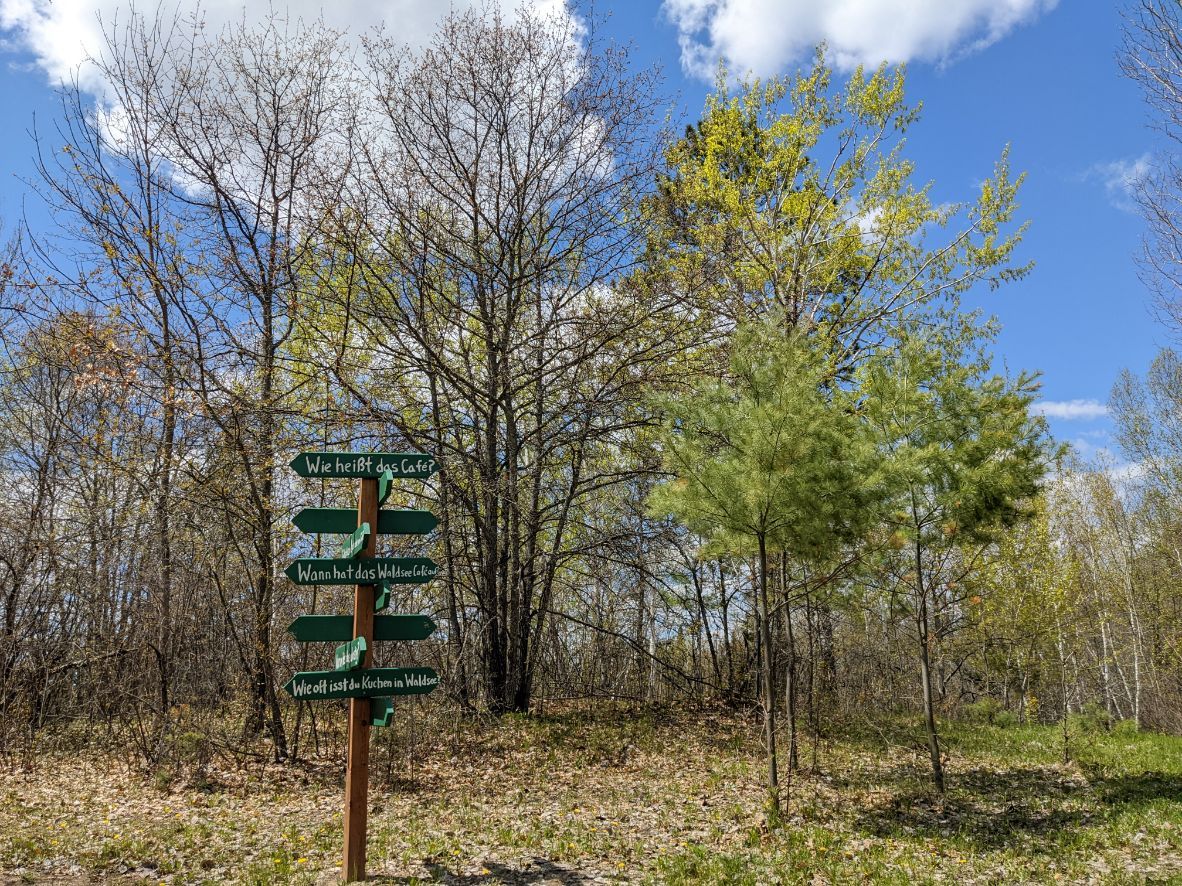
Signs in German direct campers around the Concordia Language Villages on May 23, 2022, near Bemidji, Minn. (Nora Hertel for The Optimist)
Das BioHaus models sustainable living where you might not expect it
By Nora Hertel for The Optimist
BEMIDJI - A 16-year-old building for campers in northern Minnesota holds lessons on how we can reduce our energy use and build more sustainably.
Throughout the summers, up to 24 students at a time live in Das BioHaus and practice German in a corner of the Concordia Language Villages near Bemidji. They learn about stormwater, share solar-heated water for showers, manage the blinds to help control the building’s temperature and get an inside look at the power of insulation and heat pumps.
These lessons from the Waldsee - the German language village - were cutting edge when the BioHaus opened in 2006, and they’re still useful today. The building won a Minnesota Environmental Award and was the first certified German Passive House building in the Americas. (The Passive House model is characterized by building elements that decrease energy needs to as low as 10% what traditionally-constructed buildings use.)
“It really just takes sips of the electricity,” said Warren Schulze, director of operations at Concordia Language Villages, during a tour in late May, just before the start of the summer camp season. There weren’t any children around, and birdsong carried through the clear air.
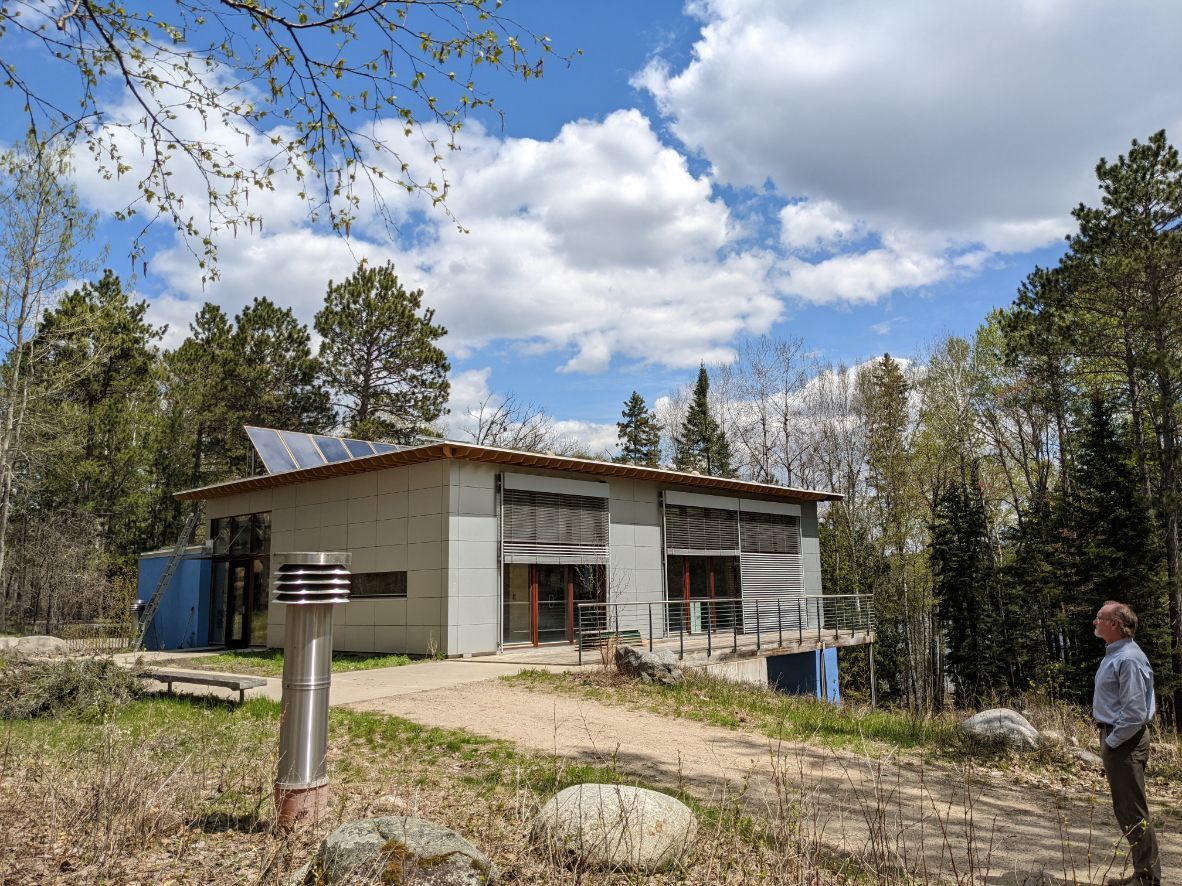
Warren Schulze, director of operations at Concordia Language Villages-Bemidji, looks at the BioHaus building on Monday, May 23, 2022. (Nora Hertel for The Optimist)
The elements that make the BioHaus unique are important today as governments, businesses and individuals strive for energy efficiency and to reduce greenhouse gas emissions.
Emissions from Minnesota’s residential buildings rose 32% from 2005 to 2018, despite the state's bipartisan Next Generation Energy Act that sought to reduce all greenhouse gas emissions statewide by 15% between 2005 and 2015.
Nationwide, residential and commercial buildings are responsible for about 29% of all greenhouse gas emissions.
Story continues below the promotion.
Promotion from The Optimist
Help us grow! Share this newsletter with friends!
Support The Optimist right now by helping us grow our mailing list! Forward an issue to a friend. Or send them a link to our sign up page!
Send a friend to our mailing list!

BioHaus is not 100% off the grid. Energy-generating solar panels may eventually close the gap.
“It would not be difficult to make this building 100% self-sustaining,” Schulze said. “We build as the money comes, and we haven’t quite had the money to add the photovoltaic panels yet.”
Photovoltaic panels turn energy from the sun into power. Hydronic solar panels, which the BioHaus does have, heat the water used in the building for showers and other domestic tasks. When there’s no sun in the forecast, the campers have to plan and share whatever hot water stores they have.
“The architect explained it best: A Passive House is not passive living. It’s active living,” Schulze said. The building was designed by Swiss-born and Twin Cities-based architect Stephan Tanner.
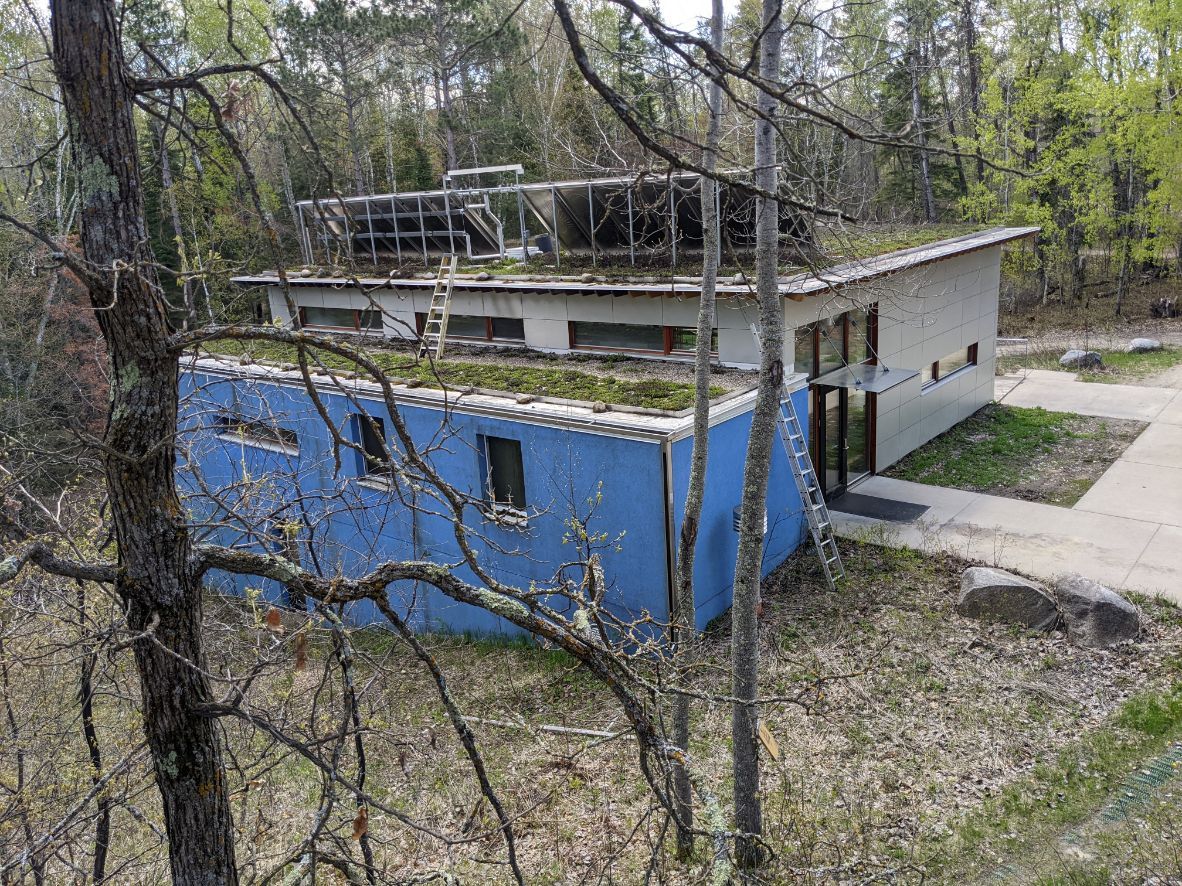
Ladders lead up to the green roof on the BioHaus which adds insulation and helps kids learn about stormwater. The panels on the roof heat the water used in the building. (Nora Hertel for The Optimist)
Much of the funding for the BioHaus came from the German government and many of the materials in the building came from Germany including its triple-paned and argon-filled windows.
Argon gas adds insulation to the windows. And insulation is a big part of what makes the BioHaus so efficient. Here’s a rundown of three different components in the building that can bring energy efficiency to new construction and renovations.
Insulation
The BioHaus uses some innovative insulation, including a green roof, in which plants and soil help reduce lost heat from the top of the building. Technically, the building didn’t need a green roof, because there was already a thick layer of insulation. But the green roof is also a teaching tool for the students who visit.
“It's a great learning opportunity for talking with kids about stormwater, you know, where does all that go,” Schulze said. “Even in the U.S. that has become a thing. How much hard surface do you have on your property, especially commercial properties, malls, with their parking lots and their big roofs.”
The building also has foam and panel insulation, including vacuum-insulated panels initially developed by NASA for heat shields in space. These panels are also used in refrigeration. But they didn’t quite take off in the U.S., because they are fragile, Schulze said.
“We were willing to try it. And our contractor here was willing to try it,” he said.
Story continues below the promotion.
Promotion from The Optimist

Did you catch our biodigester feature this month?
Biodigesters have become increasingly attractive for their renewable energy potential, the role they can play in reducing methane emissions and how they can add to the fertilizer supply now that we're facing a severe shortage. Learn how the city of St. Cloud turns waste into useful products.
Check out the story here!
Air circulation
With all that insulation, the BioHaus is very well sealed. Some older homes developed mold problems when they were sealed without good circulation. But Passive House engineers revisited the challenge and incorporated air exchange systems, Schulze explained.
There’s a silver tube that sticks out of the ground to draw in fresh air that gets circulated underground and warmed up before it’s brought into the building.
In all its years, the BioHaus air exchange system has tested clean and clear of buildup or mold.
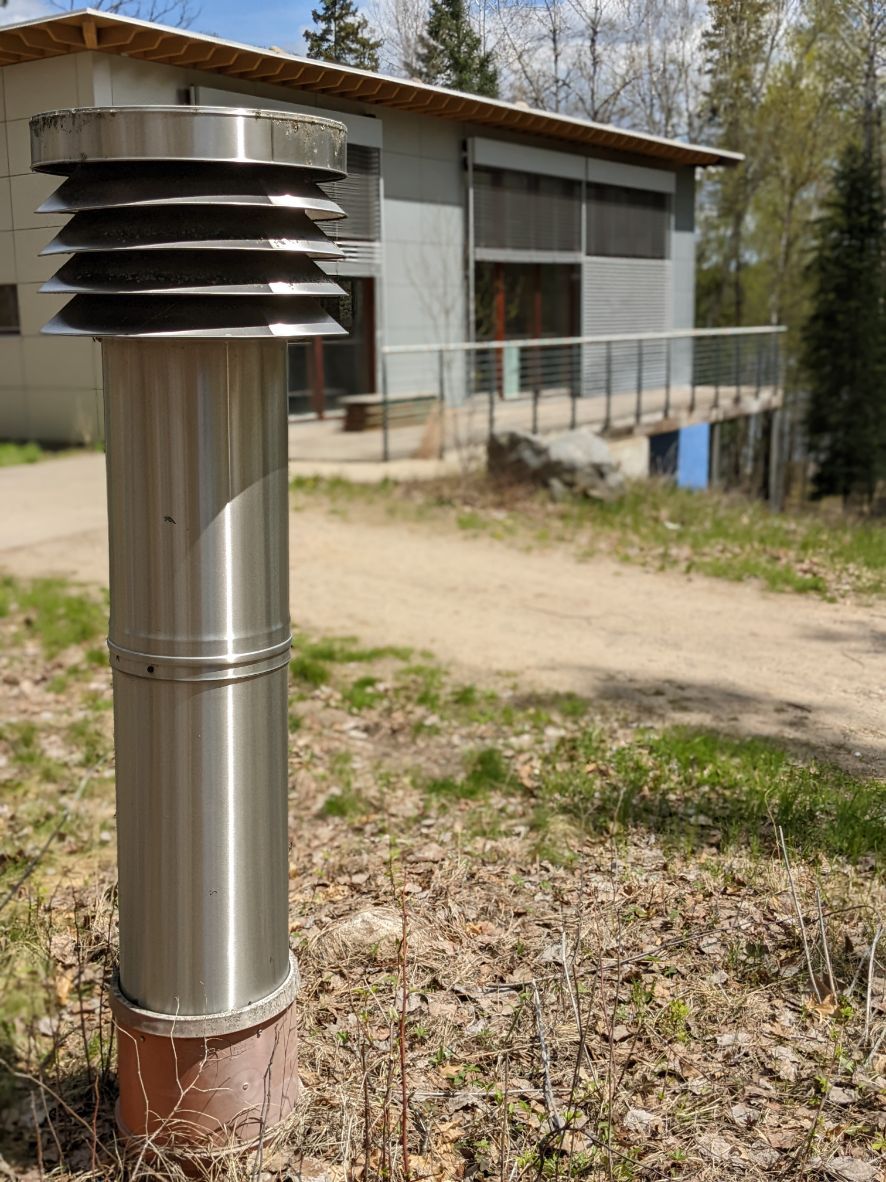
Air circulation is a key component of the BioHaus in the Concordia Language Villages-Bemidji. (Nora Hertel for The Optimist)
Temperature control
There’s space in the BioHaus mechanical room for a group of students to study the large tubes and meters of the ground-source heat pump. The system uses heat and cool air from the earth below the frost line to warm or chill air circulated in the building.
Warmth is pumped into the floors to heat the building. Sun enters through the south-facing windows to provide heat as well.
When it’s too hot, campers can adjust shades outside the windows and the temperature from the heat pump. It can’t change on a dime, but that’s part of the experience. That's the active living required in a Passive House.
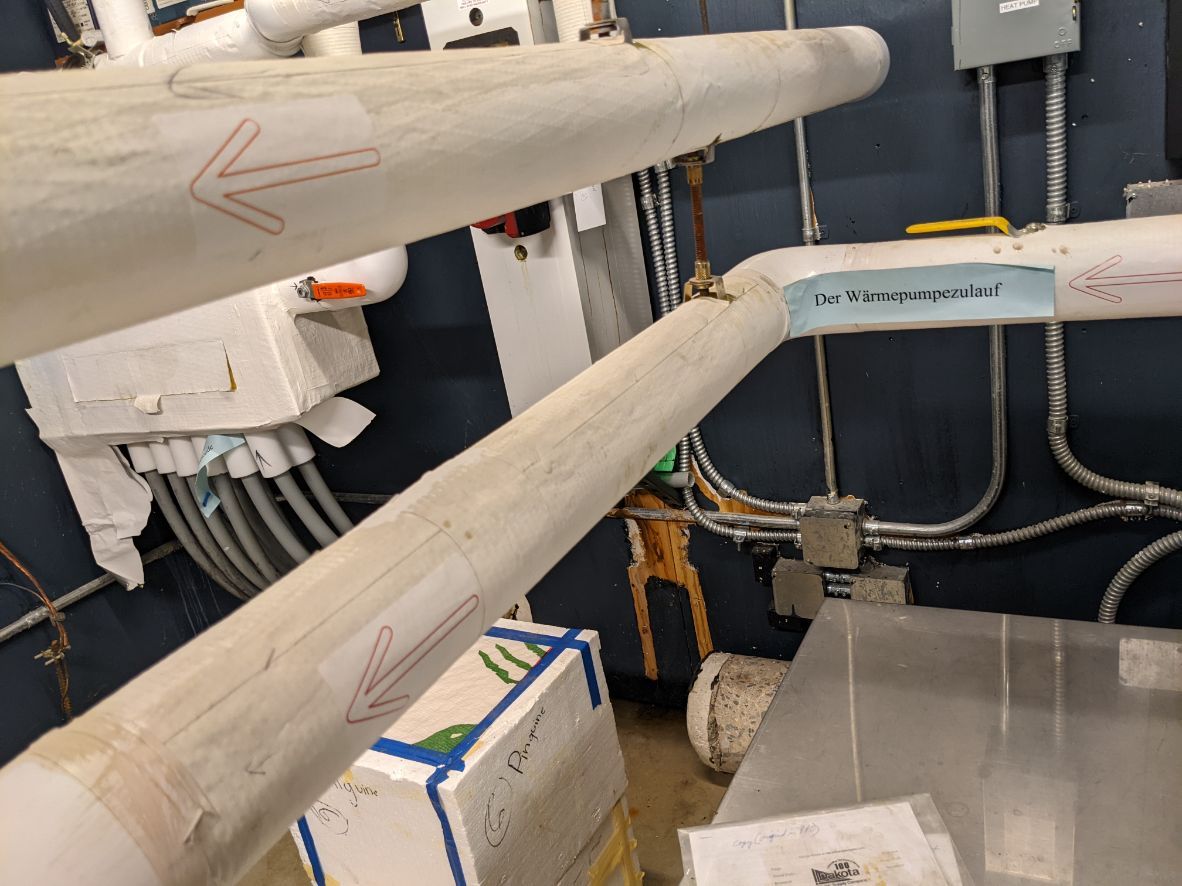
Pipes, tubes and components are labled in English and German in the BioHaus mechanical room to teach campers about the ground-source heat pump and other systems in the building. (Nora Hertel for The Optimist)
Ten years after the BioHaus opened, architect Stephan Tanner reflected on its construction and encouraged the students who pass through the camp to be change leaders and take on the environmental challenges of the day.
"We have to become WORLDHOLDERS – each one of us," Tanner wrote in a post published by Concordia Language Villages. "We have to become part of a global society that has the same equitable target and goals for all. We must understand that resources are limited and that climate action plans and implementation projects have to be local."
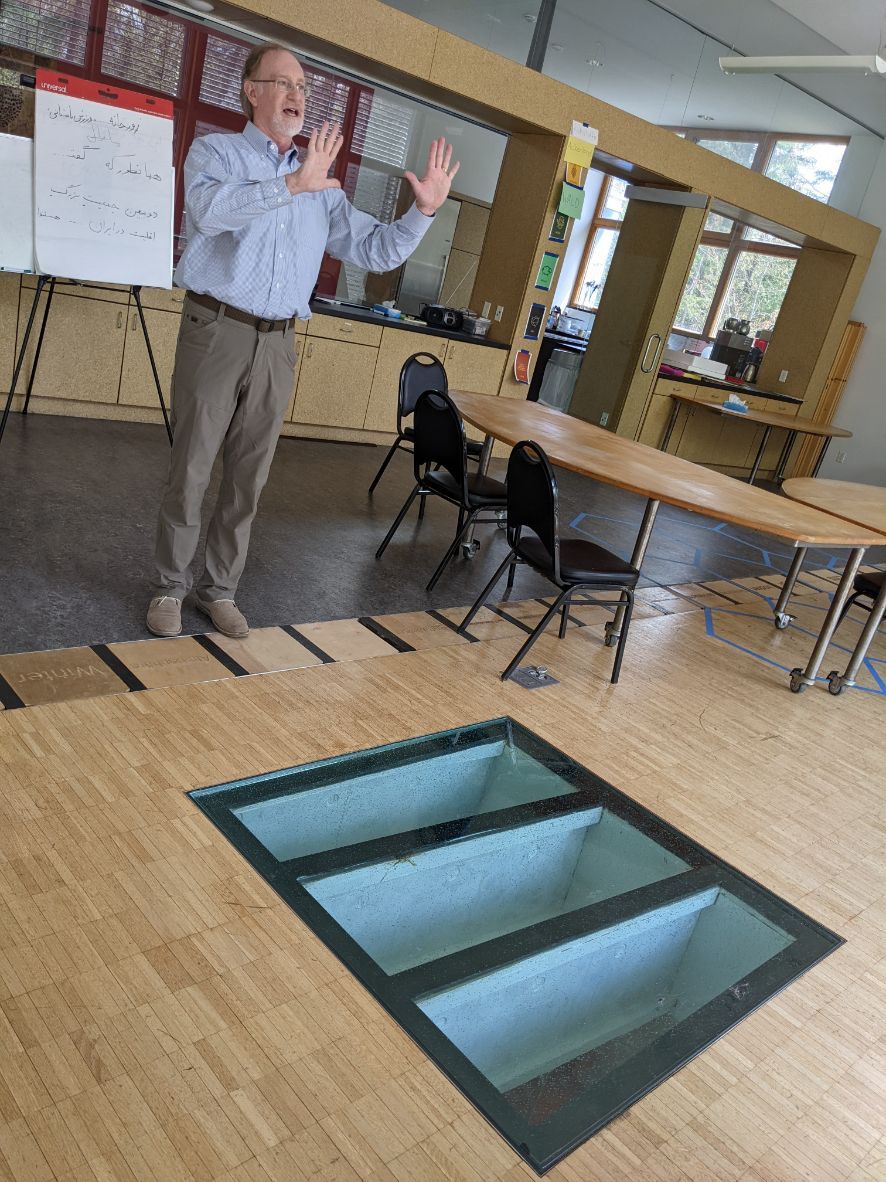
Natural lights reaches the lower level of the BioHaus through a skylight in the floor, explains Concordia Language Villages-Bemidji's Director of Operations Warren Schulze. The south-facing windows let in light and warmth. (Nora Hertel for The Optimist)
If you liked this...
I have a few more interesting models of sustainable building design for stories in the coming weeks and months. So keep looking for your newsletter each Wednesday morning.
Next week's edition will feature the lovely work of a Minnesota artist and a big announcement on The Optimist itself.
If you want to learn more about heat pumps, Minnesota's Clean Energy Resource Teams (also known as CERTs) have a great guide. Find it here.
If you want to improve the efficiency of your home, an energy audit is a good place to start. Government agencies and utility companies often provide these. A quick search online should bring you to someone local.
If you want to weatherize your home and fall into certain income categories, every state has funds from the U.S. Department of Energy to help cover the cost.
If you want to improve your insultation specifically, here's some info from Minnesota's Department of Commerce on building envelopes. "Building envelope" is a fun way to describe the barriers the separate the inside from the outside including doors, windows and insulated walls.
Thanks for reading to the end. See you next week!
Stay warm!
♥ Nora, founder of The Optimist
Our mailing address:
P.O. Box 298
St. Michael, Minnesota 55376
Copyright © 2022 The Optimist, All rights reserved.

